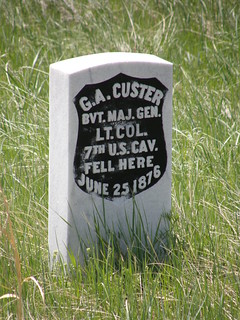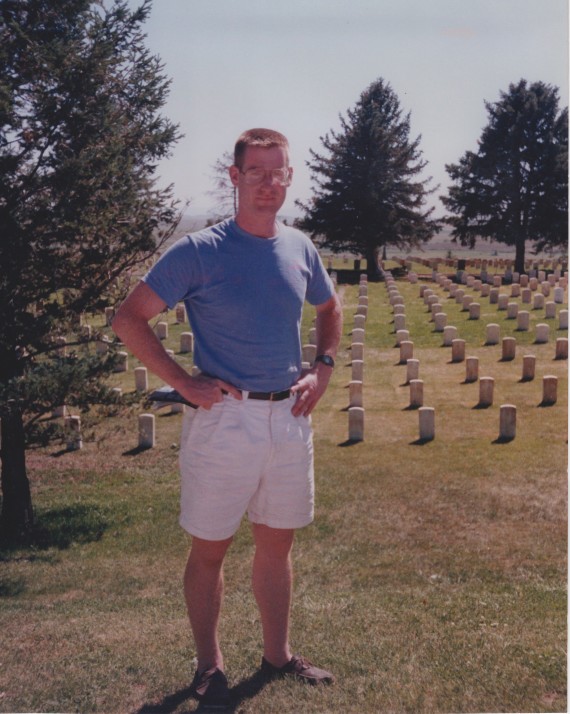
Southeastern Montana in June is beautiful. The rolling prairie with its lazy covering of tall grass carries on for as far as the eye can see. The blue sky stretches from horizon to horizon in all directions; big sky country. Occasionally, a river valley appears, along with a multitude of trees and other vegetation huddling close by to drink of the precious water. The bright shining sun basks the entire scene with an invisible blanket of warmth. In an amazing contrast of setting versus event it was near one such river valley, on a beautiful Sunday afternoon in Jun 1876, that one of the most famous battles in American history took place.
The combatants in this battle were Sioux Nation warriors including the famed Sitting Bull and Crazy Horse and five companies of the US 7th Cavalry lead by Lieutenant Colonel George Armstrong Custer. On 25 June at approximately four thirty in the afternoon, the two fighting forces collided on a hill overlooking the valley of the Little Bighorn River. When the sun finally set over the Montana sky, Sitting Bull, Crazy Horse and the Sioux warriors were engaged in rapturous celebration, while Custer and all two hundred and twenty five men under his command were dead.
Custer’s death brought about the birth of an American folk tale – the story of the Little Bighorn. Few events have stirred the imagination so vividly and been the source of so much controversy. The story has been told over and over, from generation to generation, never failing to capture the imagination of even the most disinterested listener. Its magnetism transcends all boundaries. Volumes have been written trying to piece together what took place that fateful afternoon, although it seems the more that’s written the more obscure the story becomes, until finally – unable to separate truth from fiction – it has become legend.

What is it about the Little Bighorn story that tugs at the imagination so incessantly?
First, there’s the unknown. We’ll never know, for certain, why Custer decided to attack. In hindsight, the decision appears ludicrous. He launches his cavalry, armed with single shot Springfield carbines and Colt six shot revolvers, into the Sioux Nation encampment supporting probably 2000 or more warriors armed with 41 types of firearms including the 16-shot repeating Winchester rifle.
Custer was outgunned and outmanned.
We’ll never know what he was thinking as he saw his men falling dead all around him, or when – if ever – he finally realized his entire command was on the verge of obliteration by the overwhelming power of the Sioux Nation warrior onslaught.
We’ll never know what any of his soldiers were thinking as they rode along the ridge overlooking the valley of the Little Bighorn and gazed upon the sea of attacking Sioux warriors. We’ll never know because none of Custer’s soldiers lived to talk.
Then there’s the controversial character – George Armstrong Custer. Loved by some, hated by others, he stirs people to extremes. There is no middle ground when the name Custer is mentioned. His detractors say he was arrogant, egotistical, cruel and reckless, while his supporters claim he was faithful, honorable, compassionate and gallant. That he was fearless in battle is not disputed.
Graduating last in his West Point class of 1861, he immediately went to the front lines of the raging American civil war where he earned fame for his daring, almost reckless, cavalry charges. He always escaped death, having eleven horses shot out from under him, attributing his good fortune to “Custer’s Luck.” By the end of the war, at age twenty five, he was a Major General and a national hero.
When Custer saddled up for the “Indian Campaign” of 1876, he was not only a Civil War hero but also a celebrated Indian fighter. On 17 May as he and his soldiers paraded out of Fort Abraham Lincoln near present day Bismarck North Dakota, hardly a soul considered it even remotely possible that Custer could be defeated at the hands of the Indians. To the on-looking public Custer and the 7th Cavalry presented the greatest Indian fighting unit in the field. To ride with Custer was a sign of bravery, the epitome of adventure. The 7th would be victorious, of that there was no question.
News of Custer’s crushing defeat at the Little Bighorn sent shock waves through the very heart of the young American nation just celebrating its 100th birthday and still trying to overcome the devastating effects of a civil war that took place only eleven years prior. Immediately assumptions, second guessing and arguments raged. How could any number of Sioux warriors defeat Custer? There must be a logical answer. Who is to blame? The controversy surrounding the Little Bighorn had begun and has continued ever since. It’ll probably go on for as long as there are people alive to tell the story.
A man entrenched in controversy throughout his life, it seems befitting Custer met his death at the Little Bighorn – one of the most controversial battles in history.
Ironically, his devastating defeat at the Little Bighorn – what probably should have been a reputation destroying event – jettisoned him into legendary status. The mystery surrounding what happened that Sunday afternoon near a small river in southeastern Montana only adds to the controversy and allows for the legend to take flight; almost entering the realm of the folk tale where truth and fiction collide then combine and finally – with the passage of time – become indistinguishable.
The controversy lives on. And so does the legend of the Little Bighorn and the central figure in the drama – the main protagonist – George Armstrong Custer. Whether loved or hated, he would be remembered.